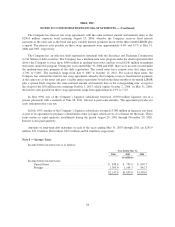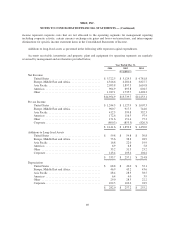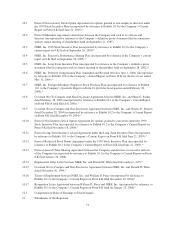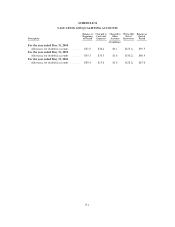Nike 2006 Annual Report Download - page 68
Download and view the complete annual report
Please find page 68 of the 2006 Nike annual report below. You can navigate through the pages in the report by either clicking on the pages listed below, or by using the keyword search tool below to find specific information within the annual report.NIKE, INC.
NOTES TO CONSOLIDATED FINANCIAL STATEMENTS — (Continued)
flows of hedged items and whether those derivatives may be expected to remain highly effective in future
periods. When it is determined that a derivative is not, or has ceased to be, highly effective as a hedge, the
Company discontinues hedge accounting prospectively.
The Company discontinues hedge accounting prospectively when (1) it determines that the derivative is no
longer highly effective in offsetting changes in the cash flows of a hedged item (including hedged items such as
firm commitments or forecasted transactions); (2) the derivative expires or is sold, terminated, or exercised; (3) it
is no longer probable that the forecasted transaction will occur; or (4) management determines that designating
the derivative as a hedging instrument is no longer appropriate.
When the Company discontinues hedge accounting because it is no longer probable that the forecasted transaction
will occur in the originally expected period, the gain or loss on the derivative remains in accumulated other
comprehensive income and is reclassified to net income when the forecasted transaction affects net income. However,
if it is probable that a forecasted transaction will not occur by the end of the originally specified time period or within
an additional two-month period of time thereafter, the gains and losses that were accumulated in other comprehensive
income will be recognized immediately in net income. In all situations in which hedge accounting is discontinued and
the derivative remains outstanding, the Company will carry the derivative at its fair value on the balance sheet,
recognizing future changes in the fair value in other expense, net. Any hedge ineffectiveness is recorded in other
expense, net. Effectiveness for cash flow hedges is assessed based on forward rates.
For each of the years ended May 31, 2006, 2005 and 2004, the Company recorded in other expense, net an
insignificant loss representing the total ineffectiveness of all derivatives. Net income for each of the years ended
May 31, 2006, 2005 and 2004 was not materially affected due to discontinued hedge accounting.
Fair Value Hedges
The Company is also exposed to the risk of changes in the fair value of certain fixed-rate debt attributable to
changes in interest rates. Derivatives currently used by the Company to hedge this risk are receive-fixed,
pay-variable interest rate swaps.
Substantially all interest rate swap agreements are designated as fair value hedges of the related long-term
debt and meet the shortcut method requirements under FAS 133. Accordingly, changes in the fair values of the
interest rate swap agreements are exactly offset by changes in the fair value of the underlying long-term debt. No
ineffectiveness has been recorded to net income related to interest rate swaps designated as fair value hedges for
the years ended May 31, 2006, 2005 and 2004.
As discussed in Note 7, during the year ended May 31, 2004, the Company issued a $50 million medium-
term note maturing October 1, 2013 and simultaneously entered into a receive-fixed, pay-variable interest rate
swap with the same notional amount and fixed interest rate as the note. However, the swap expires October 2,
2006. This interest rate swap is not accounted for as a fair value hedge, accordingly changes in the fair value of
the swap are recorded to net income each period as a component of other expense, net. The change in the fair
value of the swap was not material for the years ended May 31, 2006, 2005 and 2004.
In fiscal 2003, the Company entered into an interest rate swap agreement related to a Japanese yen
denominated intercompany loan with one of the Company’s Japanese subsidiaries. The Japanese subsidiary pays
variable interest on the intercompany loan based on 3-month LIBOR plus a spread. Under the interest rate swap
agreement, the subsidiary pays fixed interest payments at 0.8% and receives variable interest payments based on
3-month LIBOR plus a spread based on a notional amount of 8 billion Japanese yen. This interest rate swap is not
accounted for as a fair value hedge, accordingly changes in the fair value of the swap are recorded to net income
each period as a component of other expense, net. The change in the fair value of the swap was not material for
the years ended May 31, 2006, 2005 and 2004.
67
























